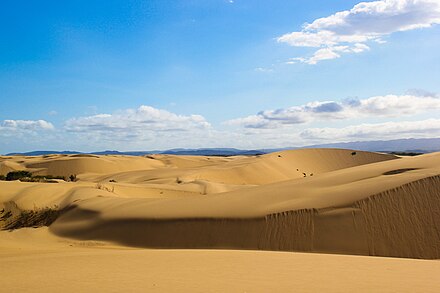 Coro is the capital of Falcón state in Venezuela. It had about 200,000 residents as of 2011.
Coro is the capital of Falcón state in Venezuela. It had about 200,000 residents as of 2011.
Understand
Santa Ana de Coro, referred to as Coro, was the first capital of Venezuela, is the oldest city in the west of Venezuela (1527) and a UNESCO World Heritage Site. Through Gran Colombia's independence from Spain, Fransisco de Miranda won Coro's port, La Vela, the first place to raise Venezuela's tricolor flag. Coro is an unconfirmed indigenous word for 'wind.'
Since 2005 Coro has been listed as an "endangered" World Heritage Site. Climate change in Venezuela, in particular heavy rains, have caused significant damage to its rich architecture. Coro's traditional buildings were built with techniques based on the use of earth (adobe, and earth reinforced with a plant structure in a technique called "bahareque"). Many of these buildings are vulnerable to heavy rains, as in its natural state earth is a material of low resistance to moisture. In 2018 UNESCO noted that there had been satisfactory advances in the implementation of many corrective measures, further actions were needed.
Get in
Travel by bus is 7 hours from Caracas. As bus stations and bus travel in Venezuela are for the more adventurous tourist, air flight to Falcon is far more common.
By plane
- José Leonardo Chirino Airport (IATA: CZE), 11.415°, -69.681667°. Punto Fijo (IATA: LSP) is an hour away and a more regular arrival destination from Caracas, Aruba, and Curacao.
By car
There are 4 main roads leading to Coro. Via Valencia and Moron there is a 4-lane highway from Caracas. From the north you can get in via the 4-lane autopista from Punto Fijo. From Maracaibo there is a good quality 2-lane highway. The road from Barquisimeto in the South through Sierra San Luis is in bad state.
By bus
Numerous night buses to Caracas depart at 22:30 and 23:00.
There is a direct bus from Mérida most days. Leaves around 18:00, takes ~12-14 hr.
To get to the 'old town' from the bus station, either use a taxi or walk. Leaving the bus station, turn right on the main street, walk for several minutes until you reach big crossroads with direction plates for 'Centro historico', where you turn left and enter Calle Zamora. The walk is 5-7 minutes.
Get around
For tourists, day trips and bilingual drivers are best. The few hotels and hostels offer day trips to the peninsula and further.
See
Some of Venezuela's best colonial architecture and cobbled streets are found in Coro, all around the historic town center. Los Medanos are shifting sand dunes rising 30 m within within walking distance of central Coro. A mini-Sahara, the dunes are the only desert-like area in Venezuela. Do not travel too far into the dunes as you may lose orientation or approached by locals warning you.
- Médanos de Coro National Park, 11.606419°, -69.737631°. A national park with lots of sand dunes just a few minutes north of Coro. 2022-05-22
Do
Do feel privileged if you travel to Coro; it is a national tourist destination. However, although it is 30 km from Aruba and Curacao, Coro does not receive foreigners too often. Coro does play a small but important piece in Venezuelan history.
Buy

Eat
On Saturdays, most restaurants are closed after 16:00.
Budget
Mid-range
Splurge
Drink
Sleep
Budget
- Posada Los Pajaros, Calle Monzón No 74, between Calles Ampíes and Comercio, opposite Plaza Monzón, +58 268 2528215, +58 416 6681566, rstiuv@hotmail.com. Check-in: 12:00, check-out: 13:00. Family run, nicely restored house. English spoken. Use of kitchen and luggage storage against 'small contribution' understood as US$2. Double with shower and aircon: US$75, but can be bargained down (2009)
- Posada El Gallo, Calle Federacion 26, Coro, +58 268 2529481, +58 268 2529801. French owner, Erick, though reports vary regarding his helpfulness and friendliness, or lack thereof.
- Hotel La Morada, Calle Zamora, +58 268-2516005.
Mid-range

- Posada Da Domenico, Av. Miranda (100 m from the airport), +58 268-2527703, +58 414-6876874 (Cel), da_domenico@hotmail.com.
- Posada Taima Taima, Calle Falcón #188, frente al Paseo Indio Manaure, Coro, +58 268-2521215, +58 268 2526053. 23 rooms with hot water and a/c. Wi-fi and internet available
It is worth the little travel to go into the Sierra San Luis. There are several posada's up there that offer great views over Coro. While sitting on the terrace of for instance Casa de Campo, you can see over Lake Coro, the city (especially bueatifull by night) and with clear weather even all the way to the Paraguana Peninsula.
Splurge
Connect
Stay safe
Cope
Go next

- Los Medanos de Coro - an impressive band of sand dunes alongside the road leading to the Paraguaná Peninsula. Get the Carabobo bus at the corner of Falcon and Manaure avenues. Get out after the big roundabout and the park entrance is to the left, 5 min walk from there to the dunes.
- Sierra de San Luis - Unspoilt mountains with wildlife and a refreshing cool climate. Ask your posada owner for the address of Senor Simon. He lives in the last house on the Via Espanol and will give you a fantastic 3-hour tour of the 3 cuaves (caves). This is really unspoiled, but easy accessible nature.
- Paraguaná Peninsula - Beaches.